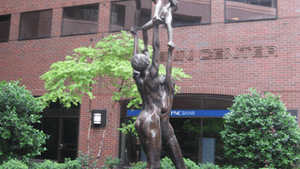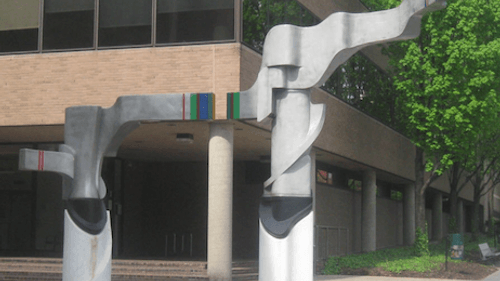Stay in the Loop
BSR publishes on a weekly schedule, with an email newsletter every Wednesday and Thursday morning. There’s no paywall, and subscribing is always free.
When public art is privately owned
Mourning the loss of Timothy Duffield's 1981 'The Family'

I walked past 1835 Market Street one afternoon and saw the sculpture was gone.
Naked to the world
It had been there since I moved to Philadelphia from Chicago in 2008, a tall bronze sculpture about a dozen feet high depicting the naked forms of a woman and man, arms stretched upward, holding aloft a young girl and boy.
I’d felt mildly shocked by their nudity, but I liked seeing them doing something wild and joyous together, and felt proud of the artist and the building’s owners for presenting those bare elbows, bellies, knees, and rear ends among the corporate towers. Their nakedness was brave, flaunting the capacity of the natural, daring body. Two adults working hard, literally lifting up the next generation, vulnerable to anything and everything under the sun.
I searched online to find out where they went, when they had been removed, and why.
Following clues
I found a Philadelphia Inquirer article from December 2015 by Pulitzer Prize-winning architecture critic Inga Saffron about planned changes along east Market Street. In it, Saffron mentioned 1835 Market: “The angled facade of that tower, designed by Kling Lindquist in 1986, creates a triangular plaza. The only purpose seemed to be to play host to the Timothy Duffield sculpture The Family. That piece is now in storage, as the owners contemplate erecting a small pavilion for a café.”
The sculpture was installed in 1981, near the corner of 18th and Market Streets, and later moved to 1835 Market. I didn’t find anything detailing where the piece was stored, if it had been scrapped, or where it might be reinstalled.
The sculpture was there for decades — why would anyone decide after more than 30 years the piece should just disappear one day without any notice? I’d recently suffered four losses: my grandmother, an uncle, my father, and a close friend, all in short time. People and things do just disappear. Friends and relatives are lost. It’s no different with art. But I didn’t feel right just leaving it at that.
When I called the Redevelopment Authority they said The Family was not a Percent for Art project. The sculpture was first commissioned by Sunoco. It changed hands as 1835 Market was bought and sold; even though it was right along the sidewalk in Center City for more than 30 years, it was always private property.
Public vs. private
The Nightingale Group now owns 1835 Market Street. They’re a “privately held, vertically integrated commercial real estate investment firm,” with property in 22 states. According to the Inquirer, they paid $100 million for the building in December 2014 and Duffield’s sculpture was part of the deal, theirs to preserve, move, donate, or scrap. The building’s previous owners maintained the sculpture, at some cost. Bronzes must be waxed regularly or they deteriorate. Nightingale seemed to have decided it wasn’t worth it.
{photo_2}
Nightingale’s 1835 property manager wouldn’t comment on the sculpture, and directed me to call someone higher up the chain. When I finally reached Brenton Hutchinson, vice president of property management, he also declined to comment. I pressed a little. “It’s been removed and that’s it?” He had no comment.
If art isn’t deemed valuable or popular to private owners, it’s cheaper to remove it and be done. Is that what happened to The Family? After decades of maintenance, was it was sold for scrap to pay country club fees? Was it still in storage?
Everything passes
“Nothing is permanent,” Duffield said when I asked him about the sculpture’s disappearance. He divides his time between Philadelphia and Utah. He and the Nightingale Group discussed the sculpture in 2015, but they couldn’t reach a solution — moving a sculpture of that size is not cheap, of course, and finding a new home is a complicated, time-consuming project.

“Had they been cooperative and wanted to make an effort, I would have done everything I could to make it work,” he said. “But I live in two different places. I’m 75 years old, and I had to ask myself, ‘Do I really want to fuss with it?’ Sometimes it’s just better to continue working than to fuss with people.”
He estimated that to create the sculpture today it would cost around $350,000. Not a bad write off if the owners found a way to donate the piece, but perhaps that wasn’t incentive enough. Duffield wasn’t told where the sculpture is. That fact, together with Nightingale’s “no comment” seems to indicate it won’t be back, if it even exists anymore.
Despite Nightingale’s removal of The Family, they still have photos of it on the building’s webpage, maybe to add virtual curb appeal, or as a gesture to posterity.
I emailed Saffron to see what she thought the loss meant for that particular block.
“I don’t have particularly strong feelings about the sculpture,” she said. “Certainly it’s been a familiar part of my urban landscape for most of my time in Philly, and I liked its verticality. My main fear is that the new owners will not follow through on their plans to activate the space, and then we’ll lose twice.”
For me, losing the sculpture was disappointing. I needed to see those four vulnerable figures every so often. Their absence now reminds me of a pattern of other disappointments and empty places in my life. A person no longer alive in a room, a fear come true, four faces I loved fading from memory. Nothing is permanent, as Duffield said. True, but that doesn’t mean we should ignore loss, or pretend it’s fine and stay silent. Silence would — to borrow Saffron’s phrase — make us lose twice for each loss we are dealt.
Sign up for our newsletter
All of the week's new articles, all in one place. Sign up for the free weekly BSR newsletters, and don't miss a conversation.

 Matthew Jakubowski
Matthew Jakubowski